
Dryopteris, commonly called the wood ferns, male ferns, or buckler ferns, is a fern genus in the family Dryopteridaceae, subfamily Dryopteridoideae, according to the Pteridophyte Phylogeny Group classification of 2016 (PPG I). There are about 300-400 species in the genus. The species are distributed in Asia, the Americas, Europe, Africa, and the Pacific islands, with the highest diversity in eastern Asia. It is placed in the family Dryopteridaceae, subfamily Dryopteridoideae, according to the Pteridophyte Phylogeny Group classification of 2016 (PPG I). Many of the species have stout, slowly creeping rootstocks that form a crown, with a vase-like ring of fronds. The sori are round, with a peltate indusium. The stipes have prominent scales.

Dryopteris expansa, the alpine buckler fern, northern buckler-fern or spreading wood fern, is a species of fern native to cool temperate and subarctic regions of the Northern Hemisphere, south at high altitudes in mountains to Spain and Greece in southern Europe, to Japan in eastern Asia, and to central California in North America. The species was first described from Germany. It prefers cool, moist mixed or evergreen forests and rock crevices on alpine slopes, often growing on rotting logs and tree stumps and rocky slopes. It is characteristically riparian in nature, and is especially associated with stream banks.

Dryopteris filix-mas, the male fern, is a common fern of the temperate Northern Hemisphere, native to much of Europe, Asia, and North America. It favours damp shaded areas in the understory of woodlands, but also shady places on hedge-banks, rocks, and screes. Near the northern limit of its distribution it prefers sunny, well-drained sites. It is much less abundant in North America than in Europe. The plant is sometimes referred to in ancient literature as worm fern, reflecting its former use against tapeworm.

Gymnocarpium dryopteris, the western oakfern, common oak fern, oak fern, or northern oak fern, is a deciduous fern of the family Cystopteridaceae. It is widespread across much of North America and Eurasia. It has been found in Canada, the United States, Greenland, China, Japan, Korea, Russia, and most of Europe. It is a seedless, vascular plant that reproduces via spores and have a life cycle with alternating, free-living sporophyte and gametophyte phases.

The Sierra Ancha is a mountain range in Gila County, in central Arizona. It lies between Roosevelt Lake to the south, the Tonto Basin to the west, Cherry Creek to the east, and Pleasant Valley to the north. The range is one of several, including the Bradshaw Mountains, Mingus Mountain of the Black Hills, and the Mazatzal Mountains, which form a transitional zone between the lowland deserts of southern Arizona and the Colorado Plateau of northeastern Arizona. The highest point in the range is Aztec Peak, at an elevation of 2345 m (7694 ft).

The small angle shades is a moth of the family Noctuidae. It is distributed throughout the Palearctic. The species was first described by Carl Linnaeus in his 1758 10th edition of Systema Naturae.

Dryopteris affinis, the scaly male fern or golden-scaled male fern, is a fern native to western and southern Europe and southwestern Asia. It is most abundant on moist soils in woodlands in areas with high humidity, such as the British Isles and western France. In the Mediterranean region and the Caucasus it is confined to high altitudes.
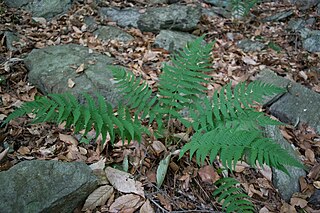
Dryopteris marginalis, vernacularly known as the marginal shield fern or marginal wood fern, is a perennial species of fern found in damp shady areas throughout eastern North America, from Texas to Minnesota and Newfoundland. It favors moderately acid to circumneutral soils in cooler areas but is fairly drought-resistant once established. In the warmer parts of its range, it is most likely to be found on north-facing non-calcareous rock faces. It is common in many altitudes throughout its range, from high ledges to rocky slopes and stream banks. Marginal wood fern's name derives from the fact that the sori are located on the margins, or edges of the leaflets.

Dryopteris arguta, with the common name coastal woodfern, is a species of wood fern. It is native to the west coast and western interior mountain ranges of North America, from British Columbia, throughout California, and into Arizona.
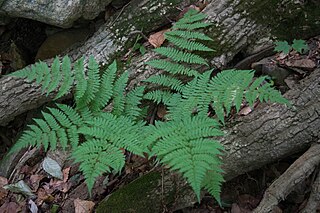
Dryopteris carthusiana is a species of fern native to damp forests throughout the Holarctic Kingdom. It is known as the narrow buckler-fern in the United Kingdom, and as the spinulose woodfern in North America.

Dryopteris cristata is a species of fern native to wetlands throughout the Northern Hemisphere. It is known as crested wood fern, crested buckler-fern or crested shieldfern. This plant is a tetraploid species of hybrid origin, one parent being Dryopteris ludoviciana and the other being the unknown, apparently extinct species, dubbed Dryopteris semicristata, which is also one of the presumed parents of Dryopteris carthusiana. D. cristata in turn is one of the parents of Dryopteris clintoniana, another fern of hybrid origin.
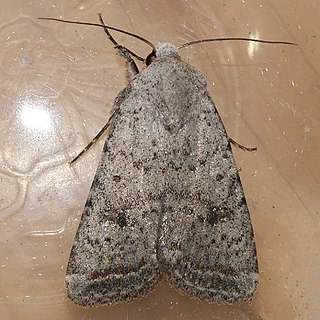
The Caradrinini are a mid-sized tribe of moths in the family Noctuidae.

Euplexia is a genus of moths of the family Noctuidae described by Stephens in 1829.
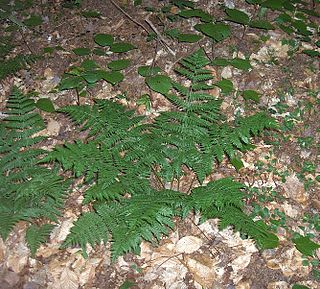
Dryopteris intermedia, the intermediate wood fern or evergreen wood fern, is a perennial, evergreen wood fern native to eastern North America. It is a diploid species, and is the parent of several species of hybrid origin, including Dryopteris carthusiana. Other common names for this species include intermediate shield fern, fancy wood fern, fancy fern, glandular wood fern, American shield fern and common wood fern.
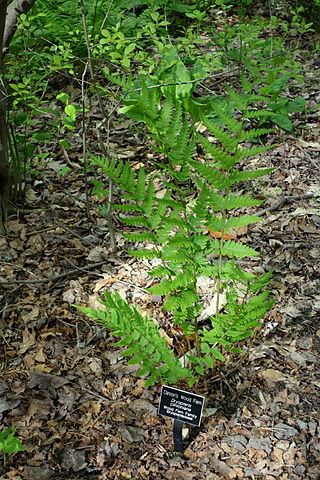
Dryopteris clintoniana, commonly known as Clinton's wood fern, is a fern of hybrid origin native to the northern hemisphere. It is a fertile hexaploid, arising as a species by doubling of its chromosome number from a hybrid between Dryopteris cristata, a tetraploid, and Dryopteris goldieana, a diploid. It is more northern in its range than either parent species.
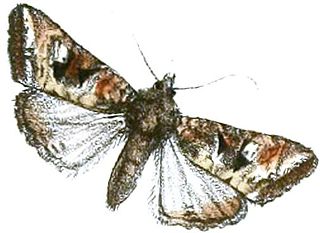
Euplexia discisignata is a species of moth of the family Noctuidae. It is found in India.

Euplexia borbonica is a moth of the family Noctuidae. It is endemic on Réunion.
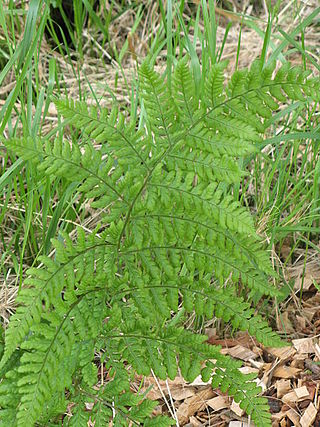
Dryopteris dilatata, the broad buckler-fern, is a robust species of deciduous or semievergreen fern in the family Dryopteridaceae, native to Europe, particularly western and central Europe. In southern Europe, it is mostly found in mountainous regions. It is also found between the Black Sea and the Caspian Sea. It grows to 90 cm (35 in) tall by 120 cm (47 in) wide, with dark green tripinnate fronds, the ribs covered in brown scales.

Filicin is a chemical compound that has been isolated from ferns of the genus Dryopteris. It has been isolated from the male fern. Filicin has been studied for its anthelmintic activity.
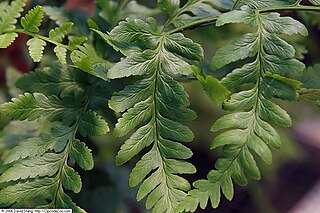
Dryopteris celsa, the log fern, is a perennial fern in the family Dryopteridaceae. It naturally occurs on rotting logs and the rich soil of swamps and wet woodlands. Its native range includes the southeastern United States.

















